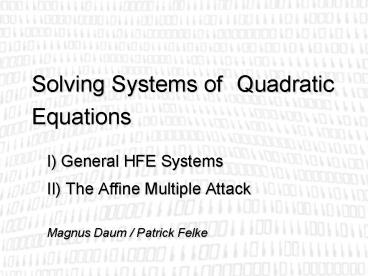Solving Systems of Quadratic Equations - PowerPoint PPT Presentation
Title:
Solving Systems of Quadratic Equations
Description:
Solving Systems of Quadratic Equations. I) General HFE Systems. II) The Affine Multiple Attack ... secret affine. transformations. public key. 9/23/09. Solving ... – PowerPoint PPT presentation
Number of Views:36
Avg rating:3.0/5.0
Title: Solving Systems of Quadratic Equations
1
Solving Systems of Quadratic Equations
- I) General HFE Systems
- II) The Affine Multiple Attack
- Magnus Daum / Patrick Felke
2
Overview of Part I
- Review of HFE Systems
- parameters, hidden polynomial
- Solving by Using Buchberger Algorithm
- special properties of HFE systems
- simulations
- 3) Number of solutions of HFE-Systems
- HFE polynomials ? general polynomials
systems of arbitrary quadratic equations
HFE systems ?
3
Review of HFE Systems
4
Review Parameters of an HFE System
n number of polynomials and
variables blocklength field extension degree
q cardinality of the smaller finite
field (fields Fq and Fq n)
d degree of the hidden polynomial
5
Review Example
6
Review Example - Encryption
7
Review Example - Encryption
8
Review Example - Decryption
9
Review Example - Decryption
without secret key solve system directly OR find
transformation to univariate polynomial of low
degree
with secret key transform back to univariate
polyno- mial of low degree
10
Review Hidden Polynomial
- transformation from univariate HFE-polynomial f
to HFE-System is always possible - (construction of the public key)
- transformation from system of quadratic equations
to an univariate polynomial representing this
system is always possible
11
Review Example - Decryption
without secret key try to solve system
directly OR try to find transformation to
univariate polynomial of low degree
with secret key transform back to univariate
polyno- mial of low degree
12
Solving HFE Systems Using Buchberger Algorithm
13
General Approach Example
14
General Approach Example
15
General Approach Example
16
General Approach Problems
- degree of output poly-nomials may get very big
- Buchberger algorithm has exponential worst case
complexity - compute all solutions in algebraic closure
17
HFE Systems are Special
- defined over a very small finite field
- include only quadratic polynomials
- need only solutions in the base field Fq
- hidden polynomial of low degree
18
HFE Systems are Special
- defined over a very small finite field
- include only quadratic polynomials
- need only solutions in the base field Fq
- hidden polynomial of low degree
19
Solutions in the Base Field
20
Solutions in the Base Field Example
21
Solutions in the Base Field Example
22
Solutions in the Base Field Example
Buchberger algorithm
- Advantages
- we compute only informa-tion we need
- degree of polynomials involved in this
compu-tation is bounded
23
HFE Systems are Special
- defined over a very small finite field
- include only quadratic polynomials
- need only solutions in the base field Fq
- hidden polynomial of low degree
24
HFE Systems are Special
- defined over a very small finite field
- include only quadratic polynomials
- need only solutions in the base field Fq
- hidden polynomial of low degree
25
Hidden Polynomial
- Patarin / Courtois
- if hidden polynomial is of low degree or special
form there are many relations between the
polynomials in the HFE system - one main idea of Buchberger algorithm is to make
use of such relations in a sophisticated way
26
HFE Systems are Special
- defined over a very small finite field
- include only quadratic polynomials
- need only solutions in the base field Fq
- hidden polynomial
27
Simulations
- 96000 simulations
- parameters
- HFE systems and random quadratic systems
- in each simulation
- generate system of quadratic equations
- (HFE or random)
- add polynomials
- solve by using Buchberger algorithm (with FGLM)
28
Simulations Dependency on n
29
Simulations Dependency on n
30
Simulations Dependency on d
31
Simulations Dependency on logqd
32
Conclusion of this Section
- Buchberger algorithm is not feasible for solving
HFE systems of usual parameters - (small q, , )
- but
- if d is very small, computation is much faster
- HFE systems with usual parameters seem to be very
similar to systems of random quadratic equations
33
Number of Solutions of HFE Systems
34
Distribution of Numbers of Solutions
35
Hints Supporting this Assumption
- numbers of zeros of general polynomials are
distributed according to the Poisson distribution - arithmetic mean and variance of the distribution
of the numbers of zeros of HFE polynomials of
bounded degree is very similar to that of a
Poisson distribution
36
Applications to HFE
- gives another hint that we may consider HFE
systems as systems of arbitrary quadratic
equations - allows to estimate the probabilities that
encryption or signing will fail and to compute
the amount of redundancy needed
37
Solving Systems of Quadratic Equations
- I) General HFE Systems
- II) The Affine Multiple Attack
38
Solving Systems of Quadratic Equations
- I) General HFE Systems
- II) The Affine Multiple Attack































